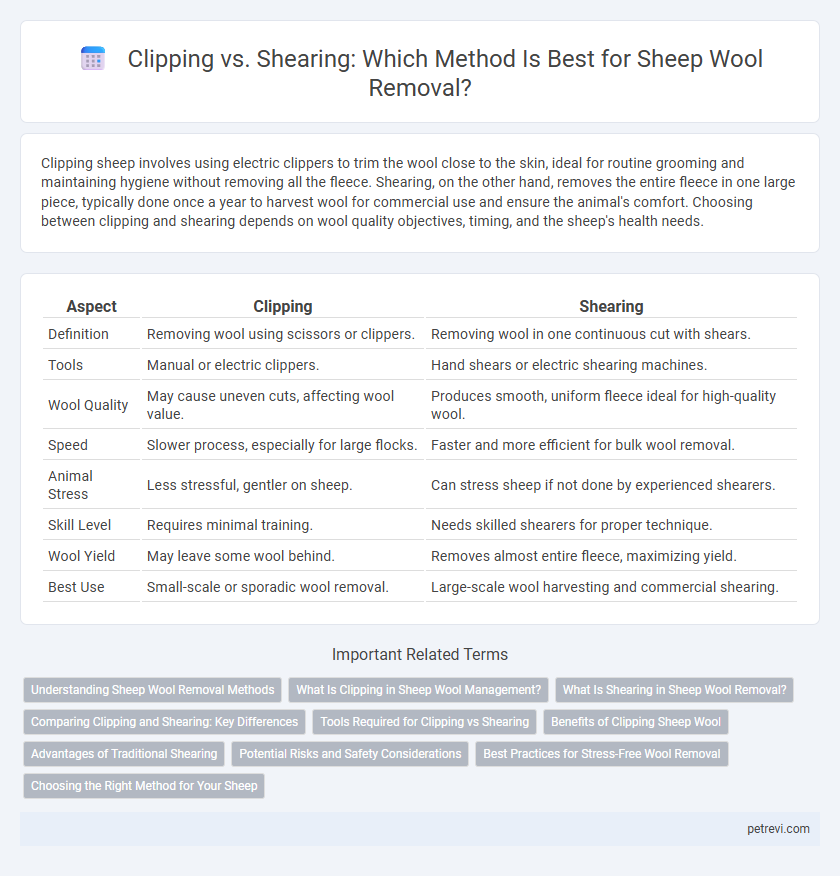Clipping sheep involves using electric clippers to trim the wool close to the skin, ideal for routine grooming and maintaining hygiene without removing all the fleece. Shearing, on the other hand, removes the entire fleece in one large piece, typically done once a year to harvest wool for commercial use and ensure the animal's comfort. Choosing between clipping and shearing depends on wool quality objectives, timing, and the sheep's health needs.
Table of Comparison
| Aspect | Clipping | Shearing |
|---|---|---|
| Definition | Removing wool using scissors or clippers. | Removing wool in one continuous cut with shears. |
| Tools | Manual or electric clippers. | Hand shears or electric shearing machines. |
| Wool Quality | May cause uneven cuts, affecting wool value. | Produces smooth, uniform fleece ideal for high-quality wool. |
| Speed | Slower process, especially for large flocks. | Faster and more efficient for bulk wool removal. |
| Animal Stress | Less stressful, gentler on sheep. | Can stress sheep if not done by experienced shearers. |
| Skill Level | Requires minimal training. | Needs skilled shearers for proper technique. |
| Wool Yield | May leave some wool behind. | Removes almost entire fleece, maximizing yield. |
| Best Use | Small-scale or sporadic wool removal. | Large-scale wool harvesting and commercial shearing. |
Understanding Sheep Wool Removal Methods
Sheep wool removal methods primarily include clipping and shearing, each with distinct techniques and outcomes. Clipping involves cutting wool close to the skin using manual or electric clippers, ensuring precise control and minimal wool damage ideal for show sheep or sensitive breeds. Shearing, typically performed with mechanical shears, quickly removes large fleece sections, maximizing wool length and quality for commercial wool production.
What Is Clipping in Sheep Wool Management?
Clipping in sheep wool management involves trimming the fleece close to the skin using electric or manual clippers, producing shorter fiber lengths compared to shearing. This method targets maintaining hygienic wool length and controlling parasite infestations without fully removing the fleece. Clipping is typically applied for wool quality improvement and health management in breeds with dense or heavy fleece.
What Is Shearing in Sheep Wool Removal?
Shearing in sheep wool removal refers to the process of cutting off the fleece using specialized shears or clippers, typically performed once a year to harvest wool efficiently. This method is essential for maintaining sheep health by preventing overheating and reducing the risk of parasite infestation. Proper shearing techniques ensure high-quality wool with minimal stress to the animal, optimizing wool yield and fiber integrity.
Comparing Clipping and Shearing: Key Differences
Clipping involves trimming the sheep's wool with electric clippers, resulting in shorter fibers and less risk of cuts, while shearing uses specialized shears or machines to remove the fleece in one piece, preserving fiber length for textile quality. Shearing is faster and ideal for harvesting entire fleeces, crucial for wool production industries, whereas clipping suits routine maintenance or areas with dense wool growth. Choosing between clipping and shearing affects wool yield, fiber integrity, and animal comfort, highlighting the importance of technique based on farming goals.
Tools Required for Clipping vs Shearing
Clipping sheep wool requires hand clippers or electric clippers designed for smaller, more detailed work, making it suitable for minor trimming or around sensitive areas. Shearing demands powerful, specialized shearing machines with long, sharp blades capable of quickly removing large fleece sections while minimizing stress on the animal. Proper maintenance of these tools, including regular blade sharpening and cleaning, is essential for efficient wool removal and animal welfare.
Benefits of Clipping Sheep Wool
Clipping sheep wool provides a cleaner and more precise removal method, reducing the risk of injury to the animal compared to shearing. The process allows for targeted trimming of wool, which helps maintain the sheep's health by preventing overheating and parasite infestations. Clipped wool also tends to be of higher quality, as it is less likely to contain dirt and vegetation, increasing its market value.
Advantages of Traditional Shearing
Traditional shearing preserves the integrity of sheep wool by removing fleece in one piece, which enhances fiber quality and facilitates easier processing. This method reduces stress and injury risks to the sheep compared to clipping, promoting better animal welfare. Shearing also allows for faster wool harvesting, making it more efficient for large-scale wool production.
Potential Risks and Safety Considerations
Clipping and shearing sheep wool both carry specific risks such as cuts, skin irritation, and heat stress, especially if performed improperly or with dull equipment. Using sharp, well-maintained tools and ensuring the animal is calm minimizes injuries and stress during wool removal. Adequate training in handling techniques and regular breaks are critical safety considerations to protect both sheep welfare and wool quality.
Best Practices for Stress-Free Wool Removal
Shearing sheep involves using electric or manual clippers to remove the wool fleece close to the skin, which is preferred for minimizing heat stress and preventing wool regrowth issues compared to clipping, which only trims the fleece. Best practices for stress-free wool removal include ensuring sheep are calm, using well-maintained sharp shearing equipment, and conducting shearing during cooler parts of the day to reduce heat stress. Proper handling techniques, such as gently restraining the sheep and avoiding sudden movements, contribute significantly to animal welfare and high-quality wool yield.
Choosing the Right Method for Your Sheep
Choosing the right method for wool removal depends on the breed, wool quality, and the sheep's health. Clipping offers precise control and is ideal for finer wool or delicate sheep, minimizing skin injuries. Shearing is faster and suits large flocks with dense wool, ensuring efficient harvesting while maintaining sheep welfare.
Clipping vs Shearing for Sheep Wool Removal Infographic

 petrevi.com
petrevi.com